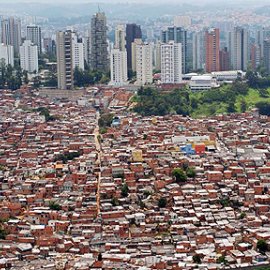Planning with Water, Part 5
-
English
-
ListenPause
I’m Peter Neill, Director of the World Ocean Observatory. As part of our World Ocean Radio multi-part series, Planning With Water, let me ask the question: what does it mean when we don’t plan with water? As we have discussed in prior editions, unlimited consumption, pollution, outdated treatment and distribution systems are evident in most cities and nations where population growth has created an ever-increasing demand. When you examine these specifics, you find that water management has been ever problematic, taken for granted, an essential resource otherwise left un-conserved and un-protected against any change in use, demand, or circumstance. Let’s take a look at the city of Sao Paulo, the largest and richest metropolis in Brazil, some 20 million inhabitants located in a country of glaciers, mountains, the Amazon River watershed, and a collection of large dams designed to exploit to the maximum what seemed to be inexhaustible water. Brazil, the “Saudi Arabia of water” as repeatedly described in press and financial reports. But today the press describes a very different picture. In a February 16 article in the New York Times, Sao Paulo is described as “a dystopian situation” where the city water pressure is critically diminished, taps are beginning to run dry, rationing is predicted, basic sanitation and hygiene are threatened, and water anarchy may be the outcome when the available supply is finally exhausted. How can this have come to pass? First, the vast amount of water available has grown a culture of unlimited consumption and expectation. So much water has nurtured a pattern of indiscriminate use and social and political indifference. The economy of the city, indeed the nation, is based on an assumption of unlimited supply. In a past Planning with Water edition, however, we discussed what is called “non-revenue” water, that which is leaked, stolen, wasted or otherwise not used or paid for as a result of rusted pipes, pumps, and valves, and long-deferred system maintenance or equipment replacement over time. Some of the San Paulo water supply is estimated to be lost to such mismanagement -- one third discarded without compensating return! As city grew to mega-city, from slums to industrial areas to commercial towers to suburban homes, the luxury of water was a given. But that same expansion and growth has had its concomitant, contradictory side effects in the form of vast volumes of water required for manufacturing, polluted, deposited in the local rivers and removed from the water cycle. To meet the demand of growing population and need for urban space, wetlands were filled, surrounding areas were cleared and constructed, and reservoirs were left inadequate to store the increase volume required. Deforestation of the rain forest changed the local micro-climate of the region, increasing run-off, erosion, and rain-fall patterns. More importantly, the more extreme changes in global warming and weather patterns, rising temperatures, and storms resulted in the larger affect of reduced mountain melt, induced drought, increased the demand for irrigation, and otherwise rapidly constricted the water capacity of the nation and undermined the economy on which the nation depends. The disruption of the predictable supply of water on the basis of daily need is a certain prelude to social and political unrest. The politicians and managers, for whatever reason, postponed or ignored the problem, and one assumes will be held somehow accountable. But that is not good enough. The crisis, long in the making, will also be long in its solution. It will require time, immediate action, leadership, community engagement, and major investment of public funds. And Sao Paulo is not the only city where similar conditions exist, an incipient crisis evident as a predictable result of climate change, lack of foresight, indifferent management, irresponsible policy, failed investment in alternative systems and behaviors, and political cowardice. I have often asked on World Ocean Radio “what will it take?” What will it take to meet the challenges of our global environmental disconnection and natural resource abuse? Will we wait until it’s too late, for the loss of what nature provides, for the crisis in health and welfare, for war and anarchy to make it better? Our last chance for water is the ocean. What’s the plan? We will discuss these issues, and more, in future editions of World Ocean Radio.
The “Planning with Water” series continues this week with discussion of the current water crisis in Brazil. In this episode of World Ocean Radio host Peter Neill asks, “What does it mean when we don’t plan with water?” and uses Sao Paolo, Brazil as an example of a mega-city in the midst of a critical water crisis, how the situation has developed over time, and what they and the rest of the world will be required to do to meet the global challenge. This episode is part of an ongoing series that looks toward building a new value premise and societal change around water as the most valuable commodity on earth, essential to our future survival.
About World Ocean Radio:
Peter Neill, Director of the World Ocean Observatory and host of World Ocean Radio, provides coverage of a broad spectrum of ocean issues from science and education to advocacy and exemplary projects. World Ocean Radio, a project of the World Ocean Observatory, is a weekly series of five-minute audio essays available for syndicated use at no cost by college and community radio stations worldwide. A selection of episodes is now available in Portuguese, Spanish, French, and Swahili. In 2015 we will add Mandarin to our roster of global languages, enabling us to reach 75% of the world's population. For more information, visit WorldOceanObservatory.org/world-ocean-radio-global.
Resources from this episode:
< Sao Paolo, Brazil: 2015 Water Crisis
< Mega Cities in Water Crisis
"Planning with Water" Series
< Part I
< Part II
< Part III
< Part IV
- Login to post comments



